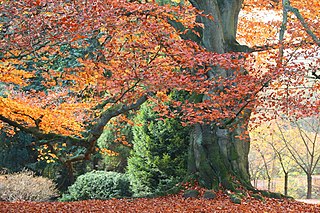
Beech (Fagus) is a genus of deciduous trees in the family Fagaceae, native to temperate Europe, Asia, and North America. Recent classifications recognize 10 to 13 species in two distinct subgenera, Engleriana and Fagus. The Engleriana subgenus is found only in East Asia, distinctive for their low branches, often made up of several major trunks with yellowish bark. The better known Fagus subgenus beeches are high-branching with tall, stout trunks and smooth silver-grey bark. The European beech is the most commonly cultivated.
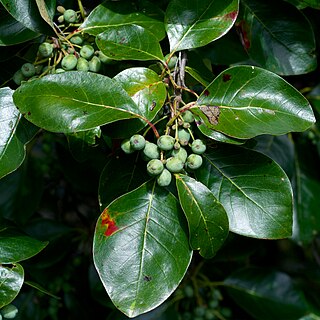
Nyssa sylvatica, commonly known as tupelo, black tupelo, black gum or sour gum, is a medium-sized deciduous tree native to eastern North America from the coastal Northeastern United States and southern Ontario south to central Florida and eastern Texas, as well as Mexico.

The wood frog has a broad distribution over North America, extending from the boreal forest of the north to the southern Appalachians, with several notable disjunct populations including lowland eastern North Carolina. The wood frog has garnered attention by biologists over the last century because of its freeze tolerance, relatively great degree of terrestrialism, interesting habitat associations, and relatively long-range movements.
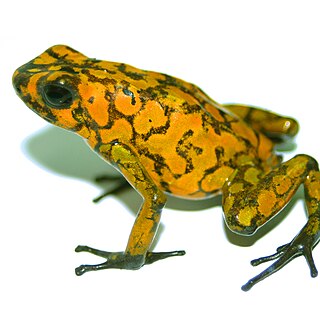
Oophaga sylvatica, sometimes known as its Spanish name diablito, is a species of frog in the family Dendrobatidae found in Southwestern Colombia and Northwestern Ecuador. Its natural habitat is lowland and submontane rainforest; it can, however, survive in moderately degraded areas, at least in the more humid parts of its range. It is a very common frog in Colombia, but has disappeared from much of its Ecuadorian range. It is threatened by habitat loss (deforestation) and agricultural pollution. It is sometimes seen in the international pet trade.
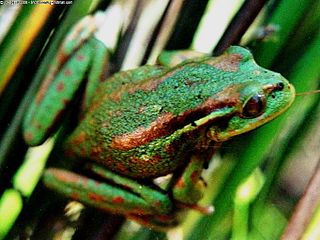
Hylorina sylvatica is a species of frog in the family Batrachylidae. It is monotypic within the genus Hylorina. It is found in Argentina and Chile. This species is endemic to the austral Nothofagus forests of Chile and Argentina with a narrow distribution along the eastern slopes of the Andes.
Phyllomacromia africana is a species of dragonfly in the family Corduliidae. It is found in the Republic of the Congo, the Democratic Republic of the Congo, Egypt, Ghana, Guinea-Bissau, Nigeria, Senegal, Sudan, Tanzania, Uganda, possibly Ethiopia, and possibly Malawi. Its natural habitats are subtropical or tropical moist lowland forests and rivers.
Phyllomacromia aureozona is a species of dragonfly in the family Corduliidae. It is found in the Republic of the Congo, the Democratic Republic of the Congo, Uganda, and Zambia. Its natural habitats are subtropical or tropical moist lowland forests and rivers.
Phyllomacromia bispina is a species of dragonfly in the family Corduliidae. It is found in the Republic of the Congo, the Democratic Republic of the Congo, Uganda, and Zambia. Its natural habitats are subtropical or tropical moist lowland forests and rivers. It is threatened by habitat loss.
Phyllomacromia congolica is a species of dragonfly in the family Corduliidae. It has lime green/yellow and black stripes. It is found in the Democratic Republic of the Congo, Malawi, Zambia, Zimbabwe, and possibly Guinea.
Phyllomacromia flavimitella is a species of dragonfly in the family Corduliidae. It is found in Central African Republic, the Democratic Republic of the Congo, Uganda, and possibly the Republic of the Congo. Its natural habitats are subtropical or tropical moist lowland forests and rivers. It is threatened by habitat loss.
Phyllomacromia kimminsi is a species of dragonfly in the family Corduliidae. It is found in Botswana, Ivory Coast, Kenya, Sierra Leone, Uganda, and Zambia. Its natural habitats are subtropical or tropical moist lowland forests and rivers.
Phyllomacromia melania is a species of dragonfly in the family Corduliidae. It is found in Angola, Cameroon, the Republic of the Congo, the Democratic Republic of the Congo, Equatorial Guinea, Gabon, Ghana, Guinea, Kenya, Liberia, Malawi, Nigeria, Sierra Leone, Tanzania, Uganda, possibly Botswana, possibly Burundi, possibly Ivory Coast, possibly Gambia, possibly Mali, possibly Mozambique, possibly Namibia, possibly Senegal, possibly South Africa, possibly Sudan, possibly Togo, possibly Zambia, and possibly Zimbabwe. Its natural habitats are subtropical or tropical moist lowland forests, rivers, intermittent freshwater lakes, and intermittent freshwater marshes.
Phyllomacromia monoceros is a species of dragonfly in the family Corduliidae. It is found in the Democratic Republic of the Congo, Kenya, Malawi, Mozambique, Somalia, South Africa, Tanzania, Uganda, Zambia, Zimbabwe, possibly Burundi, and possibly Sierra Leone. Its natural habitats are subtropical or tropical moist lowland forests, subtropical or tropical dry shrubland, subtropical or tropical moist shrubland, subtropical or tropical high-altitude shrubland, and rivers.
Phyllomacromia pallidinervis is a species of dragonfly in the family Corduliidae. It is found in Ethiopia, Kenya, and Somalia. Its natural habitats are subtropical or tropical dry shrubland, subtropical or tropical moist shrubland, and rivers. It is threatened by habitat loss.

Phyllomacromia picta is a species of dragonfly in the family Corduliidae. It is found in Angola, Botswana, Burundi, Chad, Ethiopia, Kenya, Malawi, Mozambique, Namibia, South Africa, Tanzania, Uganda, Zambia, and Zimbabwe. Its natural habitats are subtropical or tropical moist lowland forests, dry savanna, moist savanna, subtropical or tropical dry shrubland, subtropical or tropical moist shrubland, rivers, and intermittent rivers.
Phyllomacromia pseudafricana is a species of dragonfly in the family Corduliidae. It is found in Benin, Ivory Coast, Ghana, Nigeria, and Uganda. Its natural habitats are subtropical or tropical moist lowland forests and rivers.

Danes Moss Nature Reserve is a 13.4-hectare (33-acre) nature reserve south of Macclesfield, Cheshire, England. A Site of Special Scientific Interest, it is managed by the Cheshire Wildlife Trust.
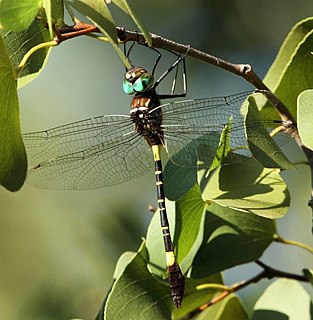
Phyllomacromia contumax, the two-banded cruiser, is a species of dragonfly in the family Corduliidae that lives in sub-Saharan Africa. Its natural habitats are woodlands, gallery forests, rivers, and lakes in subtropical or tropical savanna.
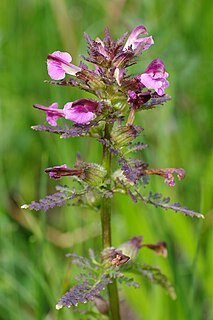
Pedicularis palustris, commonly known as marsh lousewort, is a plant species in the family Orobanchaceae. It is native to central and northern Europe and Asia where it grows in wetlands and boggy habitats. The International Union for Conservation of Nature has assessed its conservation status as being of least concern.









